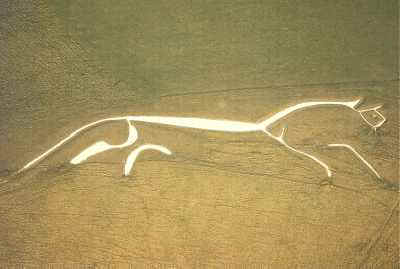The Artform of Celtic Horse Jewelry
-
Celtic History and Horse Worship

The Uffington Horse
Contemporary Celtic horse jewelry has its origins in the sculpture, carving and metalwork of the ancient Celtic peoples.
The true origins of the Celts are shrouded in the mists of prehistory. They were a loosely-knit group of tribes, having a common culture and a common language.
The Celts (Greek: "Keltoi") dominated Continental Europe (the Celts were known to the Romans as the Gauls) and the British Isles from about 1000BC onwards. At the peak of their power, they were strong enough to sack both Rome (386 BC) and Delphi (279 BC). The these victories were eventually eclipsed by the rise of the Roman Empire and the Celtic tribes were overrun and eventually were pushed back to the western fringes of the continent. When we speak today of 'Celts', we speak of people living in Ireland, Wales, Cornwall, Scotland and Brittany.
Although Celtic art has the distinction of including many forms and different influences, perhaps the most evident theme is the love of animal forms. The Celts envisioned many of their deities in the guise of animals, either as hybrids or as gods who took on the appearance of an animal for some purpose or another.
The Celts worshipped horses. One of the most famous examples of this worship is the Uffington Horse, located on a hill above Uffington in Berkshire, in the southeast of England. It is the thought to have been made by a Celtic tribe between 50BC and 50AD. The image is 374 feet long and 130 feet high and probably represents a Celtic God. It has a strange 'beaked' muzzle and the limbs are disjointed. A similar 'horse' is featured on old Celtic coins from 150BC.
When we see an example of Celtic horse jewelry, we are looking at more than a jewelry item that just happens to feature a horse; we are looking at an animal central to the Celtic culture, we are looking at "Equus".
Perhaps the best known of the deities is the Celtic goddess Epona, (from which the word pony is derived). Epona's name occurs in more inscriptions of the Roman period and with a wider distribution than any other Celtic name of god or goddess. She is the only Celtic goddess known to have been honored in Rome. She was the protectrice of the cavalry, chariot and transport. Epona even became the goddess of the Roman legionaries and is usually represented either sitting on a side saddle on a mare, or standing between two horses.
Nightmares, a name which is derived from that of the female horse, were thought by the Celts to be brought by a visiting horse Goddess such as Epona. The Celts were certainly no strangers to horses. The horse was an integral part of their life . The chroniclers of the Roman Empire documented with admiration the equestrian skills of the Celtic people they encountered in war.
In his book The Complete Book of Bits and Bitting, Elwyn Hartley Edwards credits the Celts with the invention of the curb bit as well as the horseshoe (not surprising as the Celts were the ironworkers of ancient times; the invention of horseshoeing is believed to have occurred around 500 BC)
Three of the major design elements of Celtic geometric art are knotworks, spirals and key patterns. Knotworks came surprisingly late to Celtic art, it is believed they were introduced from Coptic Christian manuscripts which were also a major source of inspiration for early Islamic art. Typical features of Celtic knotworks are the use of rounded edges and attempting to make the knotwork one continuous line. This continuous line feature is a focal point of the celtic horse jewelry found in the Anita Lang Collection.
Back to Top of Page
Back to Your Guide to Gifts for Horse Lovers Home Page
|
